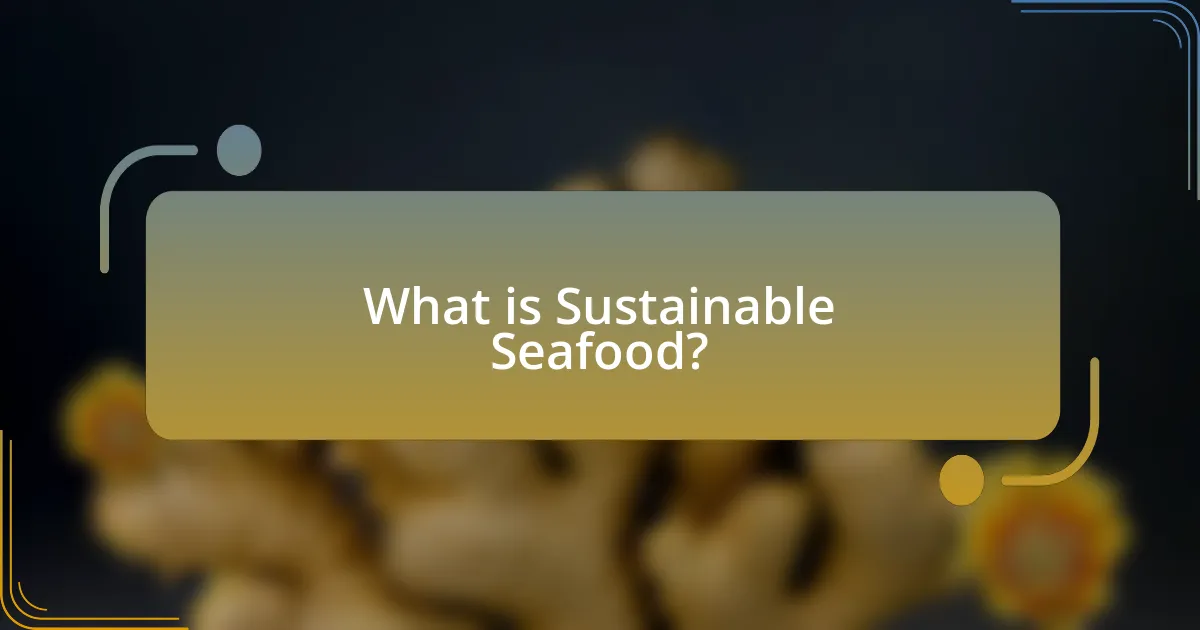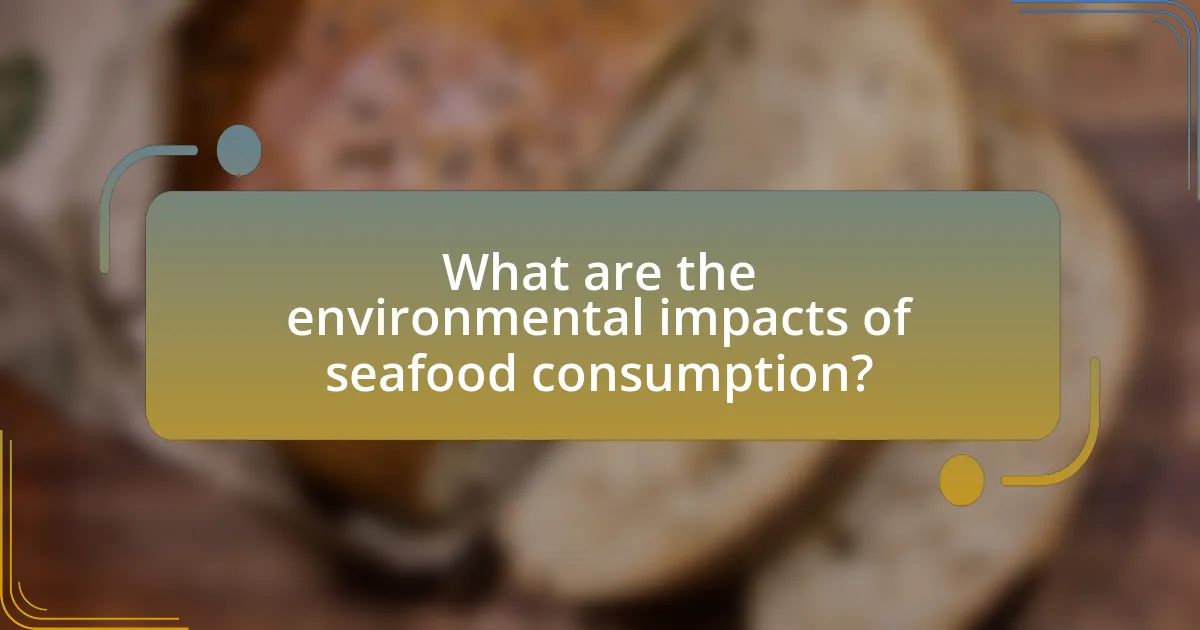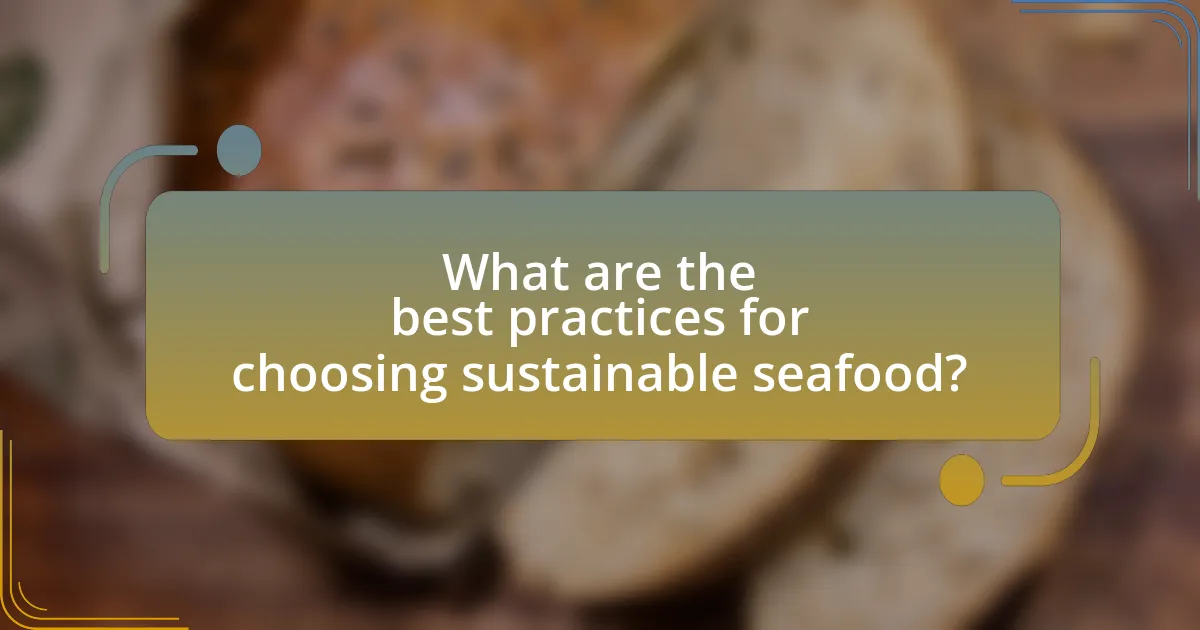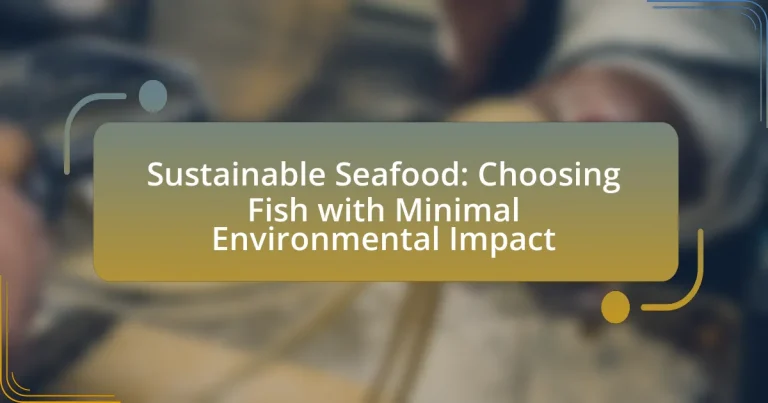Sustainable seafood refers to fish and shellfish harvested in ways that protect marine ecosystems and ensure the health of fish populations. The article outlines the importance of sustainable seafood for environmental conservation, highlighting the negative impacts of overfishing and destructive fishing practices on marine ecosystems. It discusses key principles of sustainability, responsible sourcing, and certifications that indicate sustainable practices, such as those from the Marine Stewardship Council and the Aquaculture Stewardship Council. Additionally, the article provides practical tips for consumers to identify and choose sustainable seafood options, emphasizing the social and economic benefits of supporting sustainable fishing practices.

What is Sustainable Seafood?
Sustainable seafood refers to fish and shellfish that are harvested in ways that maintain or improve the health of marine ecosystems and the populations of the species being fished. This concept is grounded in practices that ensure fish stocks are not overexploited, habitats are protected, and fishing methods do not cause significant harm to the environment. For instance, according to the Marine Stewardship Council, sustainable seafood is sourced from fisheries that are certified to meet strict environmental standards, ensuring that fishing practices are environmentally responsible and socially equitable.
Why is sustainable seafood important for the environment?
Sustainable seafood is important for the environment because it helps maintain healthy fish populations and ecosystems. Overfishing and destructive fishing practices can lead to the depletion of marine species and damage to habitats, such as coral reefs. According to the Food and Agriculture Organization, approximately 34% of global fish stocks are overfished, which disrupts the balance of marine ecosystems. By choosing sustainable seafood, consumers support fishing practices that are environmentally responsible, ensuring that fish populations can regenerate and ecosystems remain intact. This approach also promotes biodiversity, which is crucial for resilient marine environments.
How does overfishing impact marine ecosystems?
Overfishing significantly disrupts marine ecosystems by depleting fish populations and altering food webs. When key species are overfished, it leads to an imbalance in the ecosystem, as predators and prey relationships are affected. For instance, the decline of large predatory fish like tuna can result in an increase in smaller fish populations, which may overgraze on plankton and disrupt the entire marine food chain. According to a study published in the journal “Nature,” overfishing has contributed to a 90% decline in some fish populations since the mid-20th century, demonstrating its profound impact on marine biodiversity and ecosystem stability.
What role do fishing practices play in sustainability?
Fishing practices are crucial for sustainability as they directly influence fish populations, ecosystem health, and resource management. Sustainable fishing methods, such as selective gear use and catch limits, help maintain fish stocks at healthy levels, preventing overfishing and allowing ecosystems to recover. For instance, the Marine Stewardship Council reports that well-managed fisheries can lead to a 50% increase in fish populations over time. Additionally, practices that minimize bycatch and habitat destruction contribute to the overall health of marine environments, ensuring that fishing can continue without depleting resources.
What are the key principles of sustainable seafood?
The key principles of sustainable seafood include maintaining fish populations at healthy levels, minimizing environmental impact, and ensuring fair labor practices. Healthy fish populations are crucial for ecosystem balance; overfishing can lead to population collapse, as evidenced by the decline of Atlantic cod, which fell by over 90% due to unsustainable fishing practices. Minimizing environmental impact involves using fishing methods that reduce bycatch and habitat destruction, such as pole-and-line fishing, which is less harmful than trawling. Additionally, ensuring fair labor practices addresses the social aspect of sustainability, as highlighted by the Seafood Task Force, which aims to improve working conditions in the seafood supply chain. These principles collectively promote the long-term viability of seafood resources and ecosystems.
How does the concept of responsible sourcing apply to seafood?
Responsible sourcing in seafood refers to the practice of obtaining seafood from fisheries and aquaculture operations that prioritize sustainability, environmental health, and social responsibility. This concept applies to seafood by ensuring that the fish are caught or farmed in ways that do not deplete fish populations, harm ecosystems, or exploit workers. For instance, the Marine Stewardship Council (MSC) certification indicates that a fishery meets strict sustainability standards, which include maintaining fish stocks at healthy levels and minimizing environmental impact. Additionally, responsible sourcing often involves traceability, allowing consumers to know the origin of their seafood, thus promoting transparency and accountability in the supply chain.
What certifications indicate sustainable seafood practices?
Certifications that indicate sustainable seafood practices include the Marine Stewardship Council (MSC) certification, the Aquaculture Stewardship Council (ASC) certification, and the Best Aquaculture Practices (BAP) certification. The MSC certification focuses on wild-caught seafood, ensuring that fisheries are well-managed and sustainable, while the ASC certification applies to farmed seafood, promoting responsible aquaculture practices. The BAP certification encompasses both farmed and processed seafood, emphasizing environmental and social responsibility. These certifications are recognized globally and are based on rigorous standards that assess the sustainability of seafood sources, helping consumers make informed choices that support environmental conservation.
How can consumers identify sustainable seafood options?
Consumers can identify sustainable seafood options by looking for certifications from reputable organizations such as the Marine Stewardship Council (MSC) or the Aquaculture Stewardship Council (ASC). These certifications indicate that the seafood has been sourced responsibly, adhering to environmental standards that minimize ecological impact. For example, the MSC label signifies that the fish comes from a fishery that is well-managed and sustainable, while the ASC label ensures that farmed seafood meets strict environmental and social criteria. Additionally, consumers can consult resources like the Seafood Watch program, which provides recommendations based on sustainability assessments of various seafood products.
What labels should consumers look for when purchasing seafood?
Consumers should look for labels such as the Marine Stewardship Council (MSC) certification, the Aquaculture Stewardship Council (ASC) certification, and the Seafood Watch recommendations when purchasing seafood. The MSC label indicates that the seafood is sourced from sustainable fisheries that are well-managed and environmentally responsible. The ASC certification signifies that farmed seafood meets strict environmental and social standards. Additionally, Seafood Watch provides guidelines based on sustainability assessments, helping consumers choose seafood that has minimal environmental impact. These labels are backed by rigorous standards and assessments, ensuring that consumers can make informed choices that support sustainable practices in the seafood industry.
How can consumers research the sustainability of seafood products?
Consumers can research the sustainability of seafood products by utilizing resources such as seafood sustainability guides, certification labels, and online databases. Seafood sustainability guides, like those provided by the Marine Stewardship Council and the Monterey Bay Aquarium’s Seafood Watch, offer detailed information on which seafood choices are environmentally responsible. Certification labels, such as the Marine Stewardship Council or the Aquaculture Stewardship Council, indicate that products meet specific sustainability standards. Additionally, online databases like FishChoice and the Seafood Watch app allow consumers to access real-time information about the sustainability of various seafood options. These resources collectively help consumers make informed decisions that align with sustainable practices in seafood consumption.

What are the environmental impacts of seafood consumption?
Seafood consumption has significant environmental impacts, primarily through overfishing, habitat destruction, and pollution. Overfishing depletes fish populations faster than they can reproduce, leading to ecosystem imbalances; for instance, the United Nations Food and Agriculture Organization reported that 34% of global fish stocks are overfished. Habitat destruction occurs through practices like bottom trawling, which damages ocean floors and disrupts marine ecosystems. Additionally, seafood farming can contribute to pollution through the discharge of waste and chemicals into surrounding waters, affecting local biodiversity. These factors collectively threaten marine life and the health of ocean ecosystems.
How does seafood production affect ocean health?
Seafood production significantly impacts ocean health through overfishing, habitat destruction, and pollution. Overfishing depletes fish populations, disrupting marine ecosystems and leading to imbalances in species interactions. For instance, the Food and Agriculture Organization reported that approximately 34% of global fish stocks are overfished, which threatens biodiversity and the resilience of ocean ecosystems. Additionally, practices such as bottom trawling destroy critical habitats like coral reefs and seafloor ecosystems, further compromising marine life. Pollution from aquaculture, including excess nutrients and chemicals, can lead to harmful algal blooms, which deplete oxygen levels and create dead zones. These factors collectively illustrate how seafood production can detrimentally affect ocean health.
What are the consequences of habitat destruction caused by fishing?
Habitat destruction caused by fishing leads to significant ecological consequences, including loss of biodiversity and disruption of marine ecosystems. Overfishing and destructive fishing practices, such as bottom trawling, physically damage habitats like coral reefs and seafloor ecosystems, resulting in the decline of species that depend on these environments. According to a study published in the journal “Nature,” bottom trawling can reduce species richness by up to 50% in affected areas, highlighting the severe impact on marine life. Additionally, the destruction of habitats can lead to altered food webs, affecting not only fish populations but also the livelihoods of communities that rely on fishing for sustenance and economic stability.
How do bycatch and discards contribute to environmental issues?
Bycatch and discards significantly contribute to environmental issues by depleting marine biodiversity and disrupting ecosystems. Bycatch refers to the unintended capture of non-target species during fishing, which can lead to population declines in vulnerable species, including endangered ones. For instance, studies indicate that bycatch can account for up to 40% of total catch in some fisheries, resulting in substantial mortality rates for these non-target species. Discards, the practice of throwing back unwanted or non-commercial fish, further exacerbates this problem as many discarded fish do not survive due to stress or injury, contributing to waste and loss of marine life. This loss of biodiversity can destabilize marine ecosystems, affecting food webs and the overall health of ocean environments.
What are the social implications of sustainable seafood?
Sustainable seafood has significant social implications, primarily by promoting equitable access to marine resources and supporting local fishing communities. By prioritizing sustainable practices, seafood sourcing can enhance food security and livelihoods for those dependent on fishing, as it encourages responsible management of fish stocks and ecosystems. For instance, the Marine Stewardship Council reports that sustainable fisheries can lead to improved economic stability for communities, as they often provide better wages and working conditions compared to unsustainable practices. Additionally, sustainable seafood initiatives can foster community engagement and awareness about marine conservation, leading to stronger social cohesion and collective action towards environmental stewardship.
How does sustainable seafood support local fishing communities?
Sustainable seafood supports local fishing communities by ensuring that fish populations remain healthy and that fishing practices do not deplete resources. This approach promotes long-term economic stability for these communities, as sustainable practices can lead to consistent fish availability and better market prices. According to the Marine Stewardship Council, sustainable fisheries can enhance local economies by providing jobs and supporting local businesses, which rely on fishing as a primary source of income. Additionally, sustainable seafood initiatives often involve community engagement, empowering local fishers to participate in decision-making processes that affect their livelihoods.
What are the economic benefits of choosing sustainable seafood?
Choosing sustainable seafood leads to long-term economic benefits by supporting healthier fish populations and ecosystems, which in turn ensures the viability of fishing industries. Sustainable practices help maintain fish stocks, reducing the risk of overfishing, which can lead to economic collapse in fishing communities. For instance, the Marine Stewardship Council reports that sustainable fisheries can yield up to 20% more fish over time compared to non-sustainable practices. Additionally, consumers increasingly prefer sustainably sourced seafood, driving demand and potentially increasing prices for sustainably caught fish, thereby benefiting local economies.

What are the best practices for choosing sustainable seafood?
To choose sustainable seafood, prioritize seafood certified by reputable organizations such as the Marine Stewardship Council (MSC) or the Aquaculture Stewardship Council (ASC). These certifications indicate that the seafood is sourced from fisheries or farms that adhere to sustainable practices, ensuring minimal environmental impact. Research shows that fisheries certified by MSC have a lower risk of overfishing and promote healthy ecosystems. Additionally, consult local seafood guides, like those from the Monterey Bay Aquarium, which provide updated information on sustainable choices based on regional availability and fishing practices. These guides help consumers make informed decisions that support sustainable fishing and aquaculture.
How can consumers make informed choices when buying seafood?
Consumers can make informed choices when buying seafood by researching sustainable seafood sources and understanding labeling practices. Sustainable seafood is defined as fish and shellfish that are caught or farmed in ways that consider the long-term vitality of the species and the well-being of the oceans. Consumers can refer to resources like the Marine Stewardship Council (MSC) and the Aquaculture Stewardship Council (ASC), which provide certifications for sustainably sourced seafood. Additionally, the Seafood Watch program, developed by the Monterey Bay Aquarium, offers guidelines on which seafood options are environmentally friendly based on fishing and farming practices. By utilizing these resources, consumers can select seafood that minimizes environmental impact and supports sustainable practices.
What resources are available to help consumers select sustainable options?
Consumers can utilize various resources to select sustainable seafood options, including the Marine Stewardship Council (MSC) certification, the Seafood Watch program by the Monterey Bay Aquarium, and the Environmental Defense Fund (EDF) guidelines. The MSC certification indicates that seafood is sourced from sustainable fisheries, while Seafood Watch provides a comprehensive guide that categorizes seafood based on sustainability ratings. The EDF offers tools and resources that help consumers understand the environmental impact of their seafood choices. These organizations base their recommendations on scientific research and assessments of fish populations and fishing practices, ensuring that consumers can make informed decisions that support sustainable fishing practices.
How can meal planning contribute to sustainable seafood consumption?
Meal planning can significantly contribute to sustainable seafood consumption by allowing individuals to select seafood that is certified as sustainable, thereby reducing overfishing and environmental degradation. By incorporating seafood from reputable sources, such as those certified by the Marine Stewardship Council or the Aquaculture Stewardship Council, consumers can ensure they are making choices that support fish populations and ecosystems. Research indicates that informed meal planning can lead to a 30% reduction in the consumption of unsustainable seafood, promoting healthier marine environments and biodiversity.
What are some common misconceptions about sustainable seafood?
Common misconceptions about sustainable seafood include the belief that all farmed fish are unsustainable and that wild-caught fish are always better for the environment. In reality, some aquaculture practices are environmentally responsible and can reduce pressure on wild fish populations. For instance, certain farmed species, like tilapia and catfish, are raised with lower environmental impacts compared to overfished wild species. Additionally, the sustainability of wild-caught fish depends on management practices; well-managed fisheries can be more sustainable than poorly managed ones. According to the Marine Stewardship Council, sustainable fisheries are those that are well-managed and have minimal environmental impact, highlighting that not all wild-caught seafood is inherently sustainable.
Why do some people believe sustainable seafood is more expensive?
Some people believe sustainable seafood is more expensive due to the higher costs associated with responsible fishing practices and aquaculture. Sustainable seafood often involves stricter regulations, which can lead to increased operational costs for fishermen and producers. For instance, fisheries that adhere to sustainable practices may invest in advanced technology and methods to minimize environmental impact, resulting in higher prices for consumers. Additionally, sustainable seafood is often sourced from smaller, local operations that may not benefit from economies of scale, further driving up costs.
How can consumers overcome the myth that all seafood is unsustainable?
Consumers can overcome the myth that all seafood is unsustainable by educating themselves on sustainable fishing practices and choosing seafood certified by reputable organizations. Research indicates that seafood labeled with certifications such as the Marine Stewardship Council (MSC) or the Aquaculture Stewardship Council (ASC) meets strict sustainability criteria, ensuring that the fish is sourced responsibly. Additionally, consumers can utilize resources like the Seafood Watch program, which provides updated recommendations on sustainable seafood choices based on environmental impact. By actively seeking out and supporting sustainable seafood options, consumers can contribute to healthier ocean ecosystems and dispel the misconception that all seafood is harmful to the environment.
What practical tips can help consumers choose sustainable seafood?
To choose sustainable seafood, consumers should look for certifications such as the Marine Stewardship Council (MSC) or the Aquaculture Stewardship Council (ASC), which indicate responsible fishing and farming practices. These certifications ensure that the seafood is sourced from well-managed fisheries or farms that minimize environmental impact. Additionally, consumers can consult resources like the Seafood Watch program, which provides updated recommendations on sustainable seafood choices based on environmental criteria. By prioritizing these certified options and utilizing reliable guides, consumers can significantly contribute to the sustainability of marine ecosystems.


